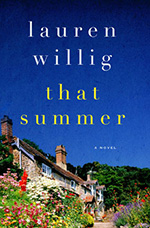 Willig is following up last year’s strong stand-alone, The Ashford Affair, with another great entry. Using a similar story structure – one section in the past and one in the present – she skillfully ties the two threads together as the story progresses. I liked both parts equally, which is not always the case, and was happy to re-join either character.
Willig is following up last year’s strong stand-alone, The Ashford Affair, with another great entry. Using a similar story structure – one section in the past and one in the present – she skillfully ties the two threads together as the story progresses. I liked both parts equally, which is not always the case, and was happy to re-join either character.
While neither this novel or The Ashford Affair can strictly be called a mystery, both novels center on a mysterious and unresolved disappearance that may or may not also be a death. So there’s a mysterious nugget in each story, though, much like a Jane Austen novel, it’s the relationships and how they may or may not work out that supply the true intrigue.
In a straight up mystery, a good writer will get the reader to question assumptions made about characters and events in determining the solution to the crime; in a good suspense/romance (for that’s what I would call this novel), the author asks the reader to question assumptions about the characters and their relationships to determine the outcome of those relationships.
Willig is very, very good at what she does. Her two plot lines are both fascinating, engaging, and catch your emotional heartstrings as you read. Her present day plot finds disaffected Julia Connelly in Manhattan, having lost her job and drifting in and out of her father’s and stepmother’s swank apartment, when she discovers she’s inherited a house in London from an aunt she doesn’t remember. She decides to go to England and clean out the house with a view to selling it.
In 1839, we meet the charming Imogen, who is taken with an antiquarian scholar visiting her vicar father with an eye on his Book of Hours. Her father dies and she marries the scholar, Arthur. She finds him to be a very different man when he takes her back home, where his dead wife’s sister keeps house for him. It’s an uncomfortable arrangement, and it’s only in 1848, when three young painters visit Arthur to look at his artifacts, that she’s roused from her decade long unhappy torpor.
The three young men are some of the original members of the Pre-Raphaelites, a group of English painters who combined an incredible technical skill and vivid use of color with a devotion to romantic subjects. One of the visitors is Dante Gabriel Rossetti, the most famous of the pre-Raphaelites; another is a fictional painter, Gavin Thorne, who is engaged to paint Imogen’s portrait.
Back in the present, Julia finds a certain kinship with the old, overgrown house, which is stuffed with family mementoes. It is, of course, Imogen’s house. A couple of long-lost cousins turn up to “welcome” her to London but really to get a look at the American cousin who has snatched the family homestead out from underneath them. One of the cousins brings along a gallery owner to appraise some of the objects in the house.
As Julia forms a friendship with Nick, the gallery owner (to her cousin Natalie’s dismay), Imogen forms a friendship with the painter. Julia also starts to remember bits of her past – her mother had been killed long ago in a car accident, prompting her father to take her to New York, and she finds the memories unsettling. Meanwhile she and Nick discover a painting in one of the wardrobes that seems to be Pre-Raphaelite, and are both set on discovering everything they can about it.
Imogen’s attachment to Gavin is more tragic. The paintings, of course, are Gavin’s, so much of the story’s energy is focused on how the two stories tie together and the unravelling of a central mystery that has plagued both the characters in the past and the characters in the present day.
Willig never overexplains, something I always appreciate. She lets you determine some things for yourself. She also gives the reader a real feel not just for the past but for the constraints of the characters who lived in 1840s London. Willig makes both stories vivid, and makes you care about each outcome. This was a delightful read, and for hardcore mystery fans, there is a mysterious death. If you’re like me, though, you won’t actually care. You’ll just savor this wonderful book.